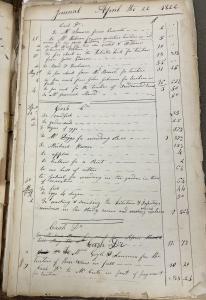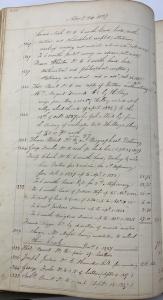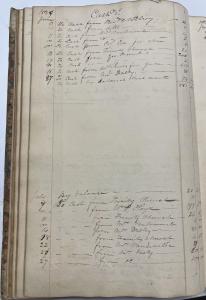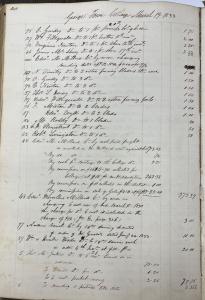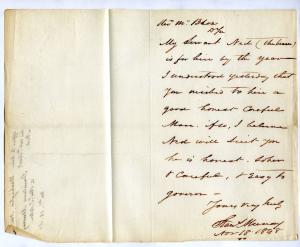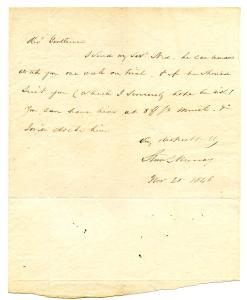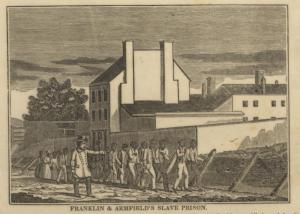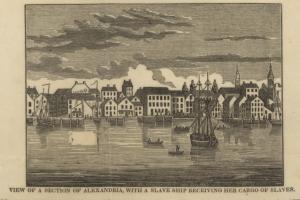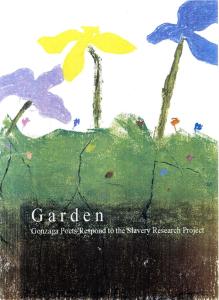During the summers of 2017 and 2018, seven students led by Gonzaga College High School teacher Ed Donnellan explored the Georgetown University Archives to answer the question: Did their school, founded as Washington Seminary, benefit from slavery?
The students discovered that the school – which operated from 1821 to 1827 and re-opened in 1848 at F Street, between 9th and 10th Streets, N.W. – participated in the slave hiring system until emancipation. Washington Seminary hired at least eight enslaved laborers to tend the gardens, cook, and perform other tasks and paid wages to their owners for that work. By uncovering the story of one of those workers Gabriel Dorsey, the students also learned that the Jesuits were not above betrayal, as they reneged on the promise of freedom and sold him to slave traders in New Orleans.
The documents in this case are among the most compelling used by the students in their exhibition “Searching for Truth in the Garden: Gonzaga’s History with Slavery,” which opened in April 2019 in the Arrupe Commons on Gonzaga’s campus and has since been displayed at Ford’s Theater in Washington and Freedom House in Alexandria. The students continue to tell the story of Gabriel and others enslaved at Washington Seminary, thereby acknowledging the role that slavery played in their school’s history and reflecting upon its significance in the present day.
Gonzaga High School teacher Ed Donnellan explores the teaching of this history and its impact in the blog post, "Teaching the History of Slavery at Gonzaga College High School."
Washington Seminary, later renamed Gonzaga Hall, c. 1877
Washington Seminary operated under a charter granted to Georgetown College at this location on F Street between 9th and 10th Streets, N.W., contiguous to St. Patrick’s Church, between 1821 and 1827. In 1858, ten years after re-opening, the school received an independent charter under the name Gonzaga College High School. It moved to its present-day location on North Capitol Street in 1871.
Gabriel Dorsey receives tip for weeding in garden, August 22, 1822
The first of several entries found by Gonzaga student researchers that document the use of the slave hiring system by the Jesuits of the Washington Seminary. Gabriel Dorsey -- always recorded without his surname -- received of a tip of 6 1/4¢ by on August 22, 1822, for weeding in the garden of Washington Seminary. The students later learned that the Jesuits paid Margaret Fenwick wages for the work performed by him.
Georgetown College High School/Washington Seminary Collection, Georgetown University Archives
Georgetown College Hires Out Gabriel Dorsey, October 1827
Shortly before Washington Seminary ended its operations, on October 13, 1827, the Jesuits of Georgetown College hired Gabriel Dorsey out, paying $1 per month to his owner Margaret Fenwick. On that date, they also ended their agreement to hire out Hillary, a woman also owned by Fenwick who had worked for the College since May 1, 1825.
Georgetown College Financial Records: Vault Collection, Georgetown University Archives
Gabriel Dorsey offered path to freedom, March 1828
Gabe “obtained leave to buy himself free.” Under the arrangement recorded on March 31, 1828, Gabe would pay $8 monthly until he had saved $400, when he would be freed. Such agreements helped enslavers establish obedience and loyalty.
Georgetown College Financial Records: Vault Collection, Georgetown University Archives
Georgetown College receives $450 for the sale of Gabriel Dorsey, June 18, 1828
On June 18, 1828, Georgetown College received $450 from Mr. Purvis, an agent of the slave traders Franklin & Armfield, for the sale of Gabe. His enslaver Margaret Fenwick had passed away one month earlier, on May 17. Instead of honoring the terms of self-purchase, her heirs the Jesuits initiated a transaction that ended with his transport to New Orleans.
Georgetown College Financial Records: Vault Collection, Georgetown University Archives
Agents' fee in sale credited to student's account, March 1833
The Jesuits continued to profit from the sale of Gabriel Dorsey as late as March 19, 1833. The fee for the services of Joshua Millward, who served as an agent in the sale, were credited toward the student account of his son Edward M. Millard, as noted in the cash book “by commission for the sale of Gabe $450 at 5[%] . . . $22.50.”
Georgetown College Financial Records: Vault Collection, Georgetown University Archives
Enslaver recommends his servant for hire at Washington Seminary, November 1848
A pair of letters written by Stanislaus Murray in November 1848 to the rector of Washington Seminary, John Blox, S.J., demonstrated the most important qualities sought by enslavers for their servants. Understanding that Father Blox was seeking “a good honest careful Man,” Murray recommended Ned who was “honest, sober, & careful, & easy to govern _ .“ Demonstrating that point, Ned carried the recommendation letter and the subsequent letter stating the terms of the hiring arrangement to Father Blox. As agreed upon, Murray received $8 per month for Ned’s work through March 1849.
Gonzaga College High School / Washington Seminary Collection, Georgetown University Archives
Views of the Alexandria slave market, 1835
These engravings of the prison work camp of slave traders Franklin & Armfield (presently the site of Freedom House) and the boarding of a slave ship in the Potomac harbor illustrate the terror inflicted upon Gabriel Dorsey and other victims of the domestic slave trade. The vignettes were two of the nine illustrations included in a broadside "The Slave Market of America," distributed in 1835 by the American Anti-Slavery Society to create support for a petition drive to abolish the slave trade in the District of Columbia.
Slave Market of America, 1835 (details)
Broadside published by the American Anti-Slavery Society
Printed ephemera collection, Library of Congress Rare Books and Special Collections Division
Gonzaga students honor Gabriel Dorsey and other victims of the domestic slave trade, November 2023
On November 9, 2023, ninety students walked in silence from Freedom House, the site of the holding pen of slave traders’ Franklin & Armfield, to the Alexandria waterfront to commemorate Gabriel Dorsey, who was sold by the Jesuits of Georgetown College in mid-June 1829. The students read aloud the names of Gabriel and 33 others who, on November 6 of that year, boarded the brig United States to begin their voyage from Alexandria to New Orleans.
Photos courtesy of Ed Donnellan. Left: Matthew Shay, Cole Vernon, Alex Toumou. Right: Ed Donnellan, Julie Hawkins Ennis, and Mary Ann Gallagher
Garden: Gonzaga Poets Respond to the Slavery Project, March 2018
During the 2017-2018 academic year, the student club Gonzaga Poets & Writers honored the enslaved individuals exploited by the Jesuits to sustain Washington Seminary by offering their reflections in poetry. The title of this compilation is a reference to the garden that teenaged Gabriel Dorsey cleared of weeds to earn a small tip from the Jesuits in April 1822.
Edited by Joseph Fondriest (GCHS ‘19) and Marcus Stackhouse (GCHS ‘19)
Cover art by Joseph Wete (GCHS ‘19)
Booklet courtesy of Ed Donnellan, Gonzaga College High School
This online exhibition is a slight modification of one presented in the spotlight case maintained by the Booth Family Center for Special Collections during October 2024. The Library is especially grateful to Ed Donnellan, social studies teacher at Gonzaga College High School; his student researchers for uncovering the story of Gabriel Dorsey and the others enslaved at Washington Seminary; the team that developed the travelling exhibition "Searching for Truth in the Garden: Gonzaga's History with Slavery;" and the creativity of its faculty and students in exploring the meaning of this history in the present-day.
The student researchers supplemented the documentation found in the Georgetown University Archives with sources from the National Archives and Records Administration and the Notarial Archives of New Orleans. Please consult The Georgetown Slavery Archive for these and other documents related to Gonzaga College High School.


